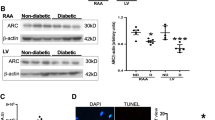Summary
Hyperglycemia is an important initiator of cardiovascular disease, contributing to the development of cardiomyocyte death and diabetic complications. The purpose of the present study was to investigate whether high glucose state could induce apoptosis of rat cardiomyocyte cell line H9c2 through microRNA-mediated Bcl-2 signaling pathway. The expression of miR-34a and Bcl-2 mRNA was detected by using real-time PCR. Western blotting was used to examine the changes in apoptosis-associated protein Bcl-2. Apoptosis of H9c2 cells was tested by using flow cytometry. The results showed that the expression of miR-34a was significantly elevated and that of Bcl-2 was strongly reduced, and apoptosis of cardiomyocytes was apparently increased in the high-glucose-treated H9c2 cells as compared with normal-glucose-treated controls. In addition, we identified Bcl-2 gene was the target of miR-34a. miR-34a mimics reduced the expression of Bcl-2 and increased glucose-induced apoptosis, but miR-34a inhibitor acted as the opposite mediator. Our data demonstrate that miR-34a contributes to high glucose-induced decreases in Bcl-2 expression and subsequent cardiomyocyte apoptosis.
Similar content being viewed by others
References
Rubler S, Dlugash J, Yuceoglu YZ, et al. New type of cardiomyopathy associated with diabetic glomerulosclerosis. Am J Cardiol, 1972,30(6):595–602
Fein FS. Diabetic cardiomyopathy. Diabetes Care, 1990,13(11):1169–1179
Regan TJ, Ahmed S, Haider B, et al. Diabetic cardiomyopathy: experimental and clinical observations. N J Med, 1994,91(11):776–778
Asbun J, Villarreal FJ. The pathogenesis of myocardial fibrosis in the setting of diabetic cardiomyopathy. J Am Coll Cardiol, 2006,47(4):693–700
Rota M, LeCapitaine N, Hosoda T, et al. Diabetes promotes cardiac stem cell aging and heart failure, which are prevented by deletion of the p66shc gene. Circ Res, 2006,99(1):42–52
Yoon YS, Uchida S, Masuo O, et al. Progressive attenuation of myocardial vascular endothelial growth factor expression is a seminal event in diabetic cardiomyopathy: restoration of microvascular homeostasis and recovery of cardiac function in diabetic cardiomyopathy after replenishment of local vascular endothelial growth factor. Circulation, 2005,111(6):2073–2085
Bartel DP. MicroRNAs: genomics, biogenesis, mechanism, and function. Cell, 2004,116(2):281–297
Rooij EV, Sutherland L, Qi X, et al. Control of stress-dependent cardiac growth and gene expression by a microRNA. Science, 2007,316(5824):575–579
Miranda KC, Huynh T, Tay Y, et al. A pattern-based method for the identification of microRNA binding sites and their corresponding heteroduplexes. Cell, 2006,126(6):1203–1217
Rooij EV, Sutherland LB, Liu N, et al. A signature pattern of stress-responsive microRNAs that can evoke cardiac hypertrophy and heart failure. Proc Natl Acad Sci USA, 2006,103(48):18 255–18 260
McKinsey TA, Olson EN. Toward transcriptional therapies for the failing heart: chemical screens to modulate genes. J Clin Invest, 2005,115(3):538–546
Rooij EV, Olson EN. MicroRNAs: powerful new regulators of heart disease and provocative therapeutic targets. J Clin Invest, 2007,117(9):2369–2376
Kong L, Zhu J, Han W, et al. Significance of serum mi croRNAs in pre-diabetes and newly diagnosed type 2 diabetes: a clinical study. Acta Diabetol, 2011,48(1): 61–69
Bertoni AG, Hundley WG, Massing MW, et al. Heart failure prevalence, incidence, and mortality in the elderly with diabetess. Diabetes Care, 2004,27:699–703
Roger VL, Go AS, Lloyd-Jones DM, et al. Heart disease and stroke statistics-2012 update: a report from the American Heart Association. Circulation, 2012,125(1): e2–220
He L, He X, Lim LP, et al. A microRNA component of the p53 tumour suppressor network. Nature, 200,447(7148):1130–1134
Dostie J, Mourelatos Z, Yang M, et al. Numerous microRNPs in neuronal cells containing novel microRNAs. RNA, 2003,9(2):180–186
Lagos-Quintana M, Rauhut R, Yalcin A, et al. Identification of tissue-specific microRNAs from mouse. Curr Biol, 2002,12(9):9
Ito T, Yagi S, Yamakuchi M. MicroRNA-34a regulation of endothelial senescence. Biochem Biophys Res Commun, 2010,398(4):735–740
Ermeking H. The miR-34 family in cancer and apoptosis. Cell Death Differ, 2010,17(2):193–199
Cole KA, Attiyeh EF, Mosse YP, et al. A functional screen identifies miR-34a as a candidate neuroblastoma tumor suppressor gene. Mol Cancer Res, 2008,6(5): 735–742
Lovis P, Roggli E, Laybutt DR, et al. Alterations in microRNA expression contribute to fatty acid-induced pancreatic beta-cell dysfunction. Diabetes, 2008,57(10): 2728–2736
Baek D, Villén J, Shin C, et al. The impact of microRNAs on protein output. Nature, 2008,455(7209):64–71
Williams AH, Liu N, Van ER, et al. MicroRNA control of muscle development and disease. Curr Opin Cell Biol, 2009,21(3):461–469
Cimmino A, Calin GA, Fabbri M, et al. miR-15 and miR-16 induce apoptosis by targeting BCL2. Proc Natl Acad Sci USA, 2005,102(39):13 944–13 949
Katare R, Caporali A, Zentilin L, et al. Intravenous gene therapy with PIM-1 via a cardiotropic viral vector halts the progression of diabetic cardiomyopathy through promotion of prosurvival signaling. Circ Res, 2011,108(10): 1238–1251
Reed JC, Meister L, Tanaka S, et al. Differential expression of bcl2 protooncogene in neuroblastoma and other human tumor cell lines of neural origin. Cancer Res, 1991,51(24):6529–6538
Bommer GT, Gerin I, Feng Y, et al. p53-mediated activation of miRNA34 candidate tumor-suppressor genes. Curr Biol, 2007,17(15):1298–1307
Chang TC, Wentzel EA, Kent OA, et al. Transactivation of miR-34a by p53 broadly influences gene expression and promotes apoptosis. Mol Cel, 2007,26(5):745–752
Yamakuchi M, Lowenstein CJ. MiR-34, SIRT1 and p53: the feedback loop. Cell Cycle, 2009,8(5):712–715
Welch C, Chen Y, Stallings RL. MicroRNA-34a functions as a potential tumor suppressor by inducing apoptosis in neuroblastoma cells. Oncogene, 2007,26(34): 5017–5022
Author information
Authors and Affiliations
Corresponding author
Additional information
This project was supported by grants from Hubei Natural Science Foundation of China (No. 2012FFB04307), Wuhan University Independent Research Projects Foundation (No. 303274034), Zhongnan Hospital of Wuhan University Hospital Foundation (No.201103), and National Natural Science Foundation of China (No. 390971103).
Rights and permissions
About this article
Cite this article
Zhao, F., Li, B., Wei, Yz. et al. MicroRNA-34a regulates high glucose-induced apoptosis in H9c2 cardiomyocytes. J. Huazhong Univ. Sci. Technol. [Med. Sci.] 33, 834–839 (2013). https://doi.org/10.1007/s11596-013-1207-7
Received:
Revised:
Published:
Issue Date:
DOI: https://doi.org/10.1007/s11596-013-1207-7




